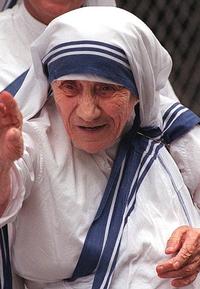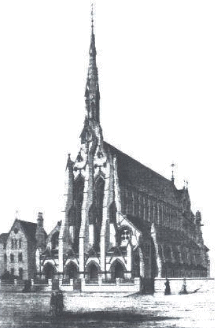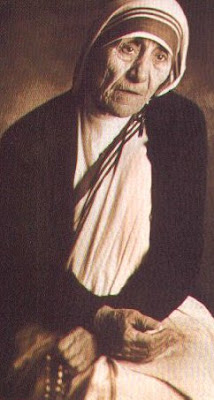December 1987
It all began more than 40 years ago when a young nun of Albanian descent received call to leave her convent in Calcutta and among the poorest of the poor. Today Mother Teresa’s Missionaries of Charity, a small army of Sisters, Brothers, priests and volunteers, bring love and caring to hundreds of thousands of the sick, hungry and homeless in 71 countries around the world.
Who is Mother Teresa, and why does her Order continue to flourish while other missionary groups decline in numbers? To find out, Reader’s Digest roving editor Courtney Tower spent seven weeks following Mother Teresa and visiting her leper colonies, AIDS facilities, schools, soup kitchens and homes for the dying and destitute. In this moving special report, he tells how she has built her life around the belief that in serving the poorest we directly serve God.
Before the 6am mass, an old nun prays alone on the floor of the scrubbed white chapel at Commissioner Lane in New Delhi, India. Then a dozen Sisters in white cotton saris trimmed with blue come to fit their voices_ “God is good! God is truth! God is love! Praise Him!” A group of unwed mothers of many faiths arrives. Several children are brought in by novice Sisters, one of whom gently tries to quiet an 18-old boy. The old nun relaxes her intense devotion and looks up with a quick smile. An Indian priest says the mass.
“The mass is ended,” says the priest. “Go in peace.” The Missionaries of Charity leave, chatting gaily, followed by 15 cheerful children, the young mothers, the priest and a foreign visitor. Alone again on the chapel floor, the tiny, aged nun, huddled inside a blue cardigan, prays on and on, speaking aloud to God.
This is Mother Teresa, the living saint of Calcutta. Later, she comes out of the chapel and, standing under a great eucalyptus tree, blesses the waiting young women, touching each head with a large, worn hand. She hugs a baby who has deformed legs, gazes tenderly at the other children.
“So beautiful,” she murmurs. Then she adds more loudly, drawing the visitor over with a glance, “They will have good homes in India and Europe. We are fighting abortion with adoption.”
I step nearer. After two years, I have managed to catch up with this bent and wrinkled old woman who is plainly very tired. At the moment, she is visiting one of the146 houses of her Order in India, oneofsome350 houses in 71 countries around the world where her Missionaries of Charity work among the poorest of the poor.
It’s clear that Mother Teresa, like any great leader, has her own management style - and it must be a successful one to feed 126,000families, teach 14,000 children in 97 schools, care for 186,000 victims of leprosy and 22,000 of the dying and destitute. With deepening admiration, I have come to call her style “according,” or as she says it, “accor-r-r-r-ding,” rolling out the r’s in her Indian-accented English.
“According to the needs,” she explains, rather shortly - since to her it is so obvious. God is love in action, she explains. And He can move you any time to serve a need. If He shows you a need to be served, He will provide the resources. So you trust totally - and you don’t organize too much.
Still, how did one woman achieve world recognition, a 1979 Nobel Peace prize, the founding of a religious order that has soared, in less than 40 years, from a membership of one to some 3,000 Sisters and 400 Brothers? “It is God’s work that has done it, not my work,” says Mother Teresa softly. “Because humanly speaking, it was not possible. He did it.”
Yes, Mother, but how do you and He go about it? How do you decide on another leper centre (there are 119), a mobile medical clinic (745, a new missionary house?
“According,” she responds.
“Do you plan your trips, Mother, or your days?”
“No. According to the needs; as many trips as necessary. Wherever Jesus wants me to go.”
For about two years I had been trying to get Mother Teresa to set a firm date to see me in Calcutta, that tragic, overwhelmed city where all her works began. She was warm in letters and telephone calls, but hard to pin down.
I soon saw why. She was travelling all over India and in Europe. Then she darted off to Ethiopia and the Sudan during the famine there. Suddenly, she was in the Philippines, Los Angeles and at the United Nations in New York. Once I tracked her to the Missionaries of Charity house in Toronto, called her and almost pleaded: “I really can’t go to Calcutta without knowing you will be there!”
“Well,” Mother Teresa responded, and surely there was a twinkle in her voice, “We will pray.”
Eventually, I went to India on assignment and, en route, missed neighbouring nation of Bangladesh. Days later, from New Delhi, I telephoned her Mother house in Calcutta.
“Oh, she’s where you are, visiting her houses in New Delhi, “I was told. But at 12 Commissioner Lane the Superior, Sister Benedicta, tells me that Mother Teresa has been and gone again, in a van on the long, hot, dusty, pot-holed drive to Chandigarh in another state. She will be back in a few days.
So I wait and learn about the New Delhi Shishu Bhavan children’s centre where Sister Benedicta and her dozen Sisters care for some 50 youngsters. Sister Benedicta, points out a baby girl found by a street sweeper, abandoned, wrapped in a rag, lying beside a crumbling pavement. “She will soon have a mother’s love,” says Sister Benedicta. The girl will be one of several hundred children placed for adoption each year by the Missionaries of Charity.
Mother Teresa returns one noon from Chardigarh, and finally we are able to chat briefly. She had been only five feet tall even before she became bent from age and toil. Her broad, strong face is deeply lined, and she has taken on the wispy, papery look of the old. But she is, nevertheless, commanding. Her blue eyes are steady, authoritative but kind. Her hands and feet are large, knobbly, with big joints - the hands and feet of an old working person who has scrubbed many a floor.
Mother Teresa is just back, but she must leave again to visit another New Delhi house. She tells me she wants “the work” known, not herself. “I am not important.” She takes a page from my notebook and writes: “Sister, Please allow Mr Tower to see the work and tape some of the comments. M.T.”
Whereupon she clasps her gnarled hands in prayer, clambers up into the van beside the driver and is off. Her 15 words open every door.
A Clear Call
Agnes Gonxhe Bojaxhiu was born in August 1910, to well-to-do Albanian parents in Skopje, now in Yugoslavia. At 18, deeply religious, knowing she wanted to help the poor, she went to the Sisters of Loreto Abbey in Dublin, where she studied English. That same year, she was sent to Darjeeling in India’s Himalayan foothills to begin her novitiate. By 1931 she was at a Loreto convent high school in Calcutta as teacher and later as principal.
On the other side of a high concrete wall, guarding Loreto’s green lawns and uniformed schoolgirls, is the Moti Jheel slum of mud lanes and wretched hovels. Sister Teresa’s room overlooked the slum. She was the dirt, the ragged children, the open sewers, the disease, the hunger in a city that was and is one giant quagmire of pestilence, poverty and famine. After school she would often go among the slum-dwellers, bringing them medicine and bandages.
On a train to Darjeeling in 1946 she heard her second call; it was “quite clear. I was to leave the convent and help the poor whilst living among them. It was an order.”
It took the obscure nun with the powerful will only two years to win permission to be a “free” nun outside the cloister. She took intensive if rudimentary medical training at Patna, in north-eastern India, and returned to the slums of Calcutta.
Her first school was a bare patch of ground, where she wrote Bengali letters in the dirt with a stick for five or six children. The slum families took notice, and some tables appeared then benches and a black-board. And more children.
Observe what is happening. Mother Teresa sees a basic need. She begins to address the need directly, simply, with what there is. The people who are assisted, then the wider community, see the good that is happening and help. So it has gone over the years. “According.”
Sister Teresa was joined in Calcutta in March 1949 by a former student from Loreto, Subashini Das, 19, who took the name Agnes. She is still number two in the Missionaries of Charity. Then others came. They lived on the top floor of a large house offered by a Bengali Christian. They begged for food and medicines for the poor, for spare land and shacks for dispensaries or schools.
The other formally began in October 1950. Sister Teresa, by now an Indian citizen, became Mother Teresa. While other Christian orders have been in decline, hers has surged ahead in members and in works. It is rooted in a simply stated basic faith. “Deep down,” explains Father George D’Campo in Calcutta, “she is a charismatic Christian who believes in the concept that in serving the poorest we are directly serving God.”
Mother Teresa has betrayed a touch of asperity about critics who would have her lead public crusades against the root causes of poverty: “That’s God’s business. It is not my business.”
“Somebody once said to me “why do you give them fish to eat? Why don’t you give them a rod to catch the fish? And I said, “But my people can’t even stand. They’re sick, crippled, demented. When I have given them fish to eat and they can stand, I’ll turn them over and you give them the rod to catch the fish!”
Mother Teresa and her missionaries do teach by example the one essential that, she says, God would have the world do about poverty. “The only thing that can remove poverty is sharing. Jesus came among the poorest, to teach people to love one another, which are to share - to use the gifts that God has given to people who have, to share with those who have not.”
The power of this woman’s lesson of love can be seen clearly in the spiritual family of the Co-Workers of Mother Teresa, which unites some three million people in 70 countries, in what she has called “the most disorganized organization in the world.”
(Continued)
*This Feature Supplement is copyright of Reader’s Digest, December 1987 and is published online for the first time. All rights reserved to the author Courtney Tower and Reader’s Digest, December 1987.
Published online by Fatmir Terziu. Please watch this video-montage: Memories of Mother Teresa:
Tuesday, 24 July 2007

The Chairman and Trustees of The Monastery of St Francis and Gorton Trust
Request the pleasure of your company at the unveiling of the sculpture
at
Gorton Monastery, Gorton Lane, Manchester
on Thursday 30th August 2007 at 4pm
Followed by a reception
JOIN US IN A CELEBRATION
at the unveiling of the sculpture
SPIRIT OF LOVE
Mother Theresa
 Designed to stand in front of the magnificent, newly refurbished Gorton Monastery the unveiling of the sculpture The spirit of Love on the 30th of August 2007 is a celebration of great significance.
Designed to stand in front of the magnificent, newly refurbished Gorton Monastery the unveiling of the sculpture The spirit of Love on the 30th of August 2007 is a celebration of great significance.
The original idea for the work came from Mr. Osman Caka, who approached the Monastery in 2004. His family fled to Mancfrester from his native, war-torn Kosovo, after Ilir, his 17 year old son was gunned down by ethnic cleansers. Osman himself could have responded in many different ways to the personal tragedy. He could have tried to seek revenge, he could have turned with hatred towards all Christians, or he could have wallowed in self pity. Instead he chose to try to create something beautiful, an object which says: Love and only love is able to overcome tragedy.
His ovwwhelning wish was to erect a sculpture, somewhere in his new country to the Albanian born Mother Theresa. Mother Theresa, a Christian woman, who was born in a Muslim country and worked chiefly among Hindus - and is revered and respected by all, is a wonderful symbol of religious tolerance.
There are also many parallels with the rising from the ashes of this deconsecrated, abused, vandalised building which was once a much loved church. The 10 year fight of the Monastery team has finally come to fruition. The building will live once more, in a spirit of peace, embracing all who come here, regardless of dfferences of faith, creed or ethnic background. The young artist, who created this work, is Andrew Scantlebury. He has worked with the Trust in a voluntary capacity for the past 5 years. From among the responses to the competition advertised in the Artist's Newsletter the jury unanimously chose his design, an abstract work, based on two hands, held gently upwards.
Plastercsts, taken from Mrs. Caka's hands and the artist's own hands served as the stadwig point fur the composition, making the work a personal statement.
2007 is particularly poignant because it is not only the year when the Manastery finally reopens as the centre of the cummunity; it is also the l0th anniversary of Mother Theresa's death. May the sculpture stand for tolerance and love for all!
 We are Very grateful for all the financial help and support we received to make this event possible. Sponsors included:
We are Very grateful for all the financial help and support we received to make this event possible. Sponsors included:
Mother Theresa, Humanitarian Charitable Swiety of Switzerland (Pjeter Gjoni, President); Exclusafe Ltd, Urmston (Mr & Mrs Moulton); A.R. Stocktons $ Co Ltd (Mr. Stockton]); AMTEC Ltd; Rawwater Ltd, GATE LLC; ACM Instruments; Mrs Moilio Regan; Ms Adetutu Fapohunda and others who wished to remain anonymous.
Heather Agan
The Monastery of St Francis and Garton Trust
The Angels, Endcott Close, West Gorton
Manchester, M18 88R
Tel: 0161 223 3211
heather.agan@theangelsmanchester.com


Nuk ka komente:
Posto një koment